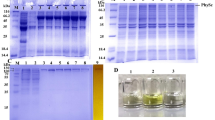Summary
The yeastSaccharomyces cerevisiae was used to express human profilin cDNA. The recombinant protein, isolated by affinity chromatography on poly(L-proline)-Sepharose followed by ion exchange chromatography, associates with non-muscle actin and phosphatidylinositol-(4,5)-bisphosphate as authentic profilin.
Similar content being viewed by others
References
Ampe, C., Markey, F., Lindberg, U. &Vandekerckhove, J. (1988) The primary structure of human platelet profilin; reinvestigation of the calf spleen profilin sequence.FEBS Lett. 228, 17–21.
Ampe, C., Vandekerckhove, J., Brenner, S. L., Tobacman, L. &Korn, E. D. (1985) The amino acid sequence of Acanthamoeba profilin.J. Biol. Chem. 260, 834–40.
Babcock, G. &Rubenstein, P. A. (1989) Synthesis of mammalian profilin inEscherichia coli and its characterization.Cell Motility and Cytoskeleton 14, 230–6.
Blikstad, I., Markey, F., Carlsson, L., Persson, T. &Lindberg, U. (1978) Selective assay of monomeric and filamentous actin in cell extracts using inhibition of deoxyribonuclease I.Cell 15, 935–43.
Bradford, M. M. (1976). A rapid and sensitive method for the quantitation of microgram quantities of protein utilizing the principle of protein-dye binding.Anal. Biochent. 72, 248–54.
Carlsson, L., Nyström, L.-E., Sundkvist, I., Markey, F. &Lindberg, U. (1977) Actin polymerizability is influenced by profilin, a low molecular weight protein in non-muscle cells.J. Mol. Biol. 115, 465–83.
Dinubile, M. J. &Southwick, F. S. (1985) Effects of macrophage profilin on actin in the presence and absence of acumentin and gelsolin.J. Biol. Chem. 260, 7402–9.
Drubin, D. G., Miller, K. G. &Botstein, D. (1988) Yeast actinbinding proteins: evidence for a role in morphogenesis.J. Cell. Biol. 107, 2551–61.
Goldschmidt-Clermont, P. J., Machesky, L. M., Baldassare, J. J. &Pollardt, T. (1990) The actin-binding protein profilin binds to PIP2 and inhibits its hydrolysis by phospholipase C.Science 247, 1575–8.
Haarer, B. K., Lillie, S. H., Adams, A. E. M., Magdolen, V., Bandlow, W. &Brown, S. S. (1990) Purification of profilin fromSaccharomyces cerevisiae and analysis of profilindeficient cells.J. Cell Biol. 110, 105–14.
Karlsson, R. (1988) Expression of chicken beta-actin inSaccharomyces cerevisiae.Gene 68, 249–57.
Kost, T. A., Theodorakis, N. &Hughes, S. H. (1983) The nucleotide sequence of the chick cytoplasmic beta-actin gene.Nucleic Acid Res. 11, 8287–301.
Kwiatkowski, D. J. &Bruns, G. A. P. (1988) Human profilin; molecular cloning, sequence comparison, and chromosomal analysis.J. Biol. Chem. 263, 5910–15.
Larsson, H. &Lindberg, U. (1988) The effects of divalent cations on the interaction between calf spleen profilin and different actins.Biochim. Biophys. Acta 953, 95–105.
Lassing, I. &Lindberg, U. (1985) Specific interaction between phosphatidylinositol 4,5-bis-phosphate and profilactin.Nature 314, 472–4.
Lassing, I. &Lindberg, U. (1988a) Evidence that the phosphoinositide cycle is linked to cell motility.Exp. Cell. Res. 174, 1–15.
Lassing, I. &Lindberg, U. (1988b) Specificity of the interaction between phosphatidylinositol 4,5-bisphosphate and the profilin: actin complex.J. Cell. Biochem. 37, 255–67.
Lindberg, U., Schutt, C. E., Hellsten, E., Tjäder, A-C. &Hult, T. (1988) The use of poly(L-proline)-Sepharose in the isolation of profilin and profilactin complexes.Biochim. Biophys. Acta 967, 391–400.
Magdolen, V., Oechsner, U., Müller, G. &Bandlow, W. (1988) The intron-containing gene for yeast profilin (PFY) encodes a vital function.Mol. Cell. Biol. 8, 5108–15.
Malm, B. (1984) Chemical modification of Cys-374 of actin interferes with the formation of profilactin complex.FEBS Lett 173, 399–402.
Malm, B., Larsson, H. &Lindberg, U. (1983) The profilin-actin complex: further characterization of profilin and studies on the stability of the complex.J. Muscle Res. Cell Motil. 4, 569–88.
Maniatis, T., Fritsch, E. F. &Sambrook, J. (1982)Molecular Cloning; A Laboratory Manual. Cold Spring Harbor, NY: Cold Spring Harbor Laboratory.
Matsudaira, P. &Burgess, D. R. (1978) SDS Microslab linear gradient polyacrylamide gel electrophoresis.Anal. Biochem. 87, 386–96.
Ng, R. &Abelson, J. (1980) Isolation and sequence of the gene for actin inSaccharomyces cerevisiae.Proc. Natn. Acad. Sci. (USA)77, 3912–16.
Nyström, L.-E., Lindberg, U., Kendrick-Jones, J. &Jakes, R. (1979) The amino acid sequence of profilin from calf spleen.FEBS Lett. 101, 161–5.
Ozaki, K. &Hatano, S. (1984) Mechanism of regulation of actin polymerization by Physarum profilin.J. Cell Biol. 98, 1919–25.
Pollard, T. D. &Cooper, J. A. (1986) Actin and actin-binding proteins. A critical evaluation of mechanisms and functions.Ann. Rev. Biochem. 55, 985–1035.
Segura, M. &Lindberg, U. (1984) Separation of non-muscle isoactins in the free form or as profilactin complexes.J. Biol. Chem. 259, 3949–54.
Sherman, F., Fink, G. R. &Hicks, J. B. (1982)Methods in Yeast Genetics. Cold Spring Harbor, NY: Cold Spring Harbor Laboratory.
Stossel, T. P., Chaponnier, C., Ezzell, R. M., Hartwig, J. H., Janmey, P. A., Kwiatkowski, D. J., Lind, S. E., Smith, D. B., Southwick, F. S., Yin, H. L. &Zauer, K. S. (1985) Non-muscle actin-binding proteins.Ann. Rev. Cell Biol. 1, 353–401.
Tobacman, L. S. &Korn, E. D. (1982) The regulation of actin polymerization and the inhibition of monomeric actin ATPase activity by Acanthamoeba profilin.J. Biol. Chem. 357, 4166–70.
Tseng, P. C.-H. &Pollard, T. D. (1982) Mechanism of action of Achanthamoeba profilin: Demonstration of actin species specificity and regulation by micromolar concentrations of MgCl2.J. Cell Biol. 94, 213–18.
Author information
Authors and Affiliations
Rights and permissions
About this article
Cite this article
Aspenström, P., Lassing, I. & Karlsson, R. Production, isolation and characterization of human profilin fromSaccharomyces cerevisiae . J Muscle Res Cell Motil 12, 201–207 (1991). https://doi.org/10.1007/BF01774039
Received:
Accepted:
Issue Date:
DOI: https://doi.org/10.1007/BF01774039




